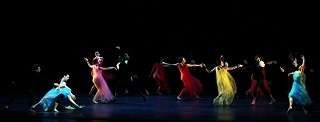|
Back
Season’s Second World Premiere Miami
Adrienne Arsht Center for the Performing Arts
03/01/2012 -
Antonin Dvorák: Carnival Overture, op. 92
George Balanchine (Music by Maurice Ravel): La Valse
Alexei Ratmansky (Music by Sergei Rachmaninoff): Symphonic Dances, op. 45
Miami City Ballet, Jennifer Carlynn Kronenberg, Carlos Miguel Guerra, Reyneris Reyes, Joshua Brown, Zoe Zien, Didier Bramaz, Tricia Alberton, Shimon Ito, Jeanette Delgado, Renan Cerdeiro, Nathalia Arja, Kleber Rebello, Renato Penteado, Callie Maqnning, Sara Esty, Yann Trividic, and corps de ballet
Cleveland Orchestra, Tito Muñoz (Conductor)
Jean Rosenthal (Scenic Design), Karinska, Adeline André (Costume Design), Jean Rosenthal, Mark Stanley (Lighting Design)

(© Joe Gato)
A coproduction between one of the world’s greatest orchestras and ballet companies is an adventure for any city and for Miami quite a coup.
Offering Dvorák’s Carnival Overture, Ravel’s Valse nobles et sentimentales and La Valse and concluding with Rachmaninoff’s Symphonic Dances without dance would still be quite an impressive program. But having choreography by Balanchine and Ratmansky in addition is almost more than one could wish for.
The most anticipated part of the program is Ratmansky’s approach to Rachmaninoff. World premieres often go down in flames. The Symphonic Dances would seem like a perfectly natural fit for ballet, and choreographers have used it several times, but the results have never caught on. Perhaps a Russian artist working with the music of a Russian composer is the answer. Imagine if a non-American had created the dances for West Side Story. Balanchine’s Western Symphonydoesn’t show any insight into the American psyche, it is all candy, and for some of us a confection that is far too sweet and artificially flavored.
Ratmansky gives us three separate narrative ballets. The first and third seem to have common themes and characters; the second has a more traditionally romantic story. Upon first viewing it doesn’t seem altogether clear how they are related. But the choreography is very fluid and will strike most as traditionally classical. Like Liam Scarlett’s Viscera which premiered in January, Ratmansky’s Symphonic Dances will have a long life. It was clear that the audience’s enthusiastic response was genuine. This is a work that aims high; there is tremendous beauty but it is the cerebral exercise that keeps us engrossed. Ratmansky encourages us to use our imaginations.
In the opening dance, we are in a society where violence and danger for men, in particular, is ubiquitous. The women, eventually all alone, are in fear and long for the return of their men. When one does return, they can’t help but all want to be in his presence, perhaps to ask if he has seen their own men. In the second dance we are at a soirée, not unlike the one we saw earlier in Balanchine’s La Valse, where two sisters are attempting flirtations. It turns into a competition where the losing sibling eventually interferes with her sister’s romances. In the end the bond of sisterhood remains solid. In the last dance a group of rogues exercises its control over a culture’s woman. Couples can’t help but fall in love yet are always cautious to ensure that their trysts are not discovered. Rachmaninoff’s music may not appear to give Ratmansky what he needs to make these situations entirely believable. It often seems too romantic for examining such harsh realities, yet undoubtedly this contradiction is what makes the work so compelling. The company demonstrates a command as if this work is already a repertory staple and like any new work, repeated viewings will encourage clearer interpretations.
This was probably also said of the first ballet of the evening, Balanchine’s La Valse, when it had its premiere over sixty years ago. Seeing that this ballet is going to be on a program can’t help but whet the appetite of any ballet lover. To once again be able to travel into this sophisticated, beautiful, perverse and ultimately dangerous world is always a treat. This time I paid particular attention to the stunning arm work that Balanchine gave to his women. Simple, tight, angular gestures give an additional language that is essential to creating the ambience. The final image of a sort of human whirlpool sucking the oxygen out of this decadent society is always one of ballet’s most thrilling finales. The company is in total control of this work; the magnificent Jennifer Carlynn Kronenberg is the girl in white being drawn into an unsuitable environment which eventually leads to her death. Miami City Ballet went for quite a few seasons without a live orchestra. I am sure I saw La Valse many times when it was performed to recorded music, but the dancers can't help but reach even higher when the Cleveland Orchestra plays Ravel’s inebriating waltzes.
People seem to have different definitions and understandings of the word “fun.” But without this, do we have any real reason to be in the theatre? I said to a friend after the performance, “wasn’t this a fun evening?” and was asked how I could see it that way. When a thoughtful artist chooses to communicate using a particular piece of music, don’t we all become children on an unfamiliar journey? Just because a dream isn’t a happy one doesn’t mean it wasn’t fascinating and memorable. Balanchine understood this better than anyone and Ratmansky appears to have learned a lot from the master.
The program opened with an exciting, yet tender and thoughtful account of Dvorák’s Carnival Overture. What a great fanfare it is for this particular adult carnival! Though one might be very familiar with this piece through recording, under the baton of Tito Muñoz, it is likely one heard many sounds for the first time.
Jeff Haller
|